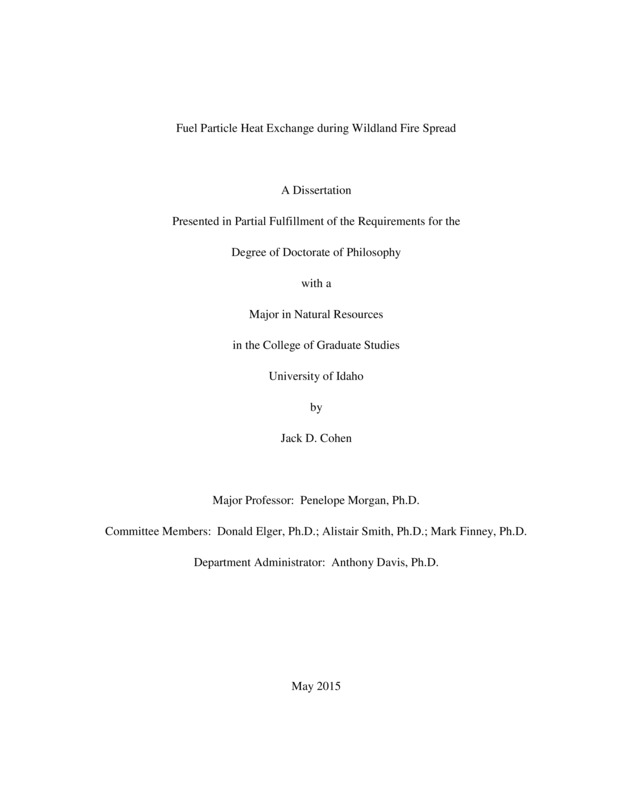Fuel Particle Heat Exchange during Wildland Fire Spread
Cohen, Jack David. (2015). Fuel Particle Heat Exchange during Wildland Fire Spread. Theses and Dissertations Collection, University of Idaho Library Digital Collections. https://www.lib.uidaho.edu/digital/etd/items/cohen_idaho_0089e_10604.html
- Title:
- Fuel Particle Heat Exchange during Wildland Fire Spread
- Author:
- Cohen, Jack David
- Date:
- 2015
- Keywords:
- fire science fuel particle heat exchange wildland fire behavior wildland fire spread
- Program:
- Natural Resources
- Subject Category:
- Natural resource management; Mechanical engineering
- Abstract:
-
Wildland fire spread is the result of fuel particle ignitions yet fuel particle heat exchange leading to ignition remains poorly understood. Current operational fire spread models are based on empirical associations and do not describe fire spread processes such as convection and radiation heat transfer. Physical fire spread models assume the heat exchange processes of particle ignition without a basis of experimental evidence. Developers of physical fire spread models have commonly assumed that radiation is the primary mechanism governing wildland fire spread. However, this assumption is unsupported by experimental evidence of fuel particle heating. The few published experiments that included fuel particle temperature measurements lead some researchers to question radiation as the principal fuel heating mechanism but importantly, none of these previous experiments resolved what mechanisms were heating fuel particles to ignition. Using controlled laboratory experiments with a physical model of fuel particle heat exchange, I measured particle boundary conditions and surface temperatures to describe how free and forced convective heat exchange non-linearly increased as particle size decreased. I demonstrated how radiantly heated fine particles cooled sufficiently to prevent ignition while the same irradiance heated coarser particles to ignition. I showed how particle heat exchange with its environment is determined by particle size and convective boundary condition development and how this is largely independent of surface area-to-volume ratio that determines fuel particle response time. Because fine fuels govern fire spread in porous fuel beds, if radiant heating is insufficient for ignition then convective heating must be the primary mechanism for fire spread. With the same coupled experimental and physical modeling approach as the controlled experiments, I examined fine fuel particle heat exchange during laboratory fire spread experiments. I measured radiation and convection boundary conditions and found radiation heating to be insufficient to ignite the fuel particles for all experiments. Convective heating from intermittent pulses of hot flame gases was the primary mechanism for fuel particle ignition. For all experiments, convective heating to ignition primarily occurred within two seconds before ignition when the flame front was within 6 cm of the particle.
- Description:
- doctoral, Ph.D., Natural Resources -- University of Idaho - College of Graduate Studies, 2015
- Major Professor:
- Morgan, Penelope
- Committee:
- Elger, Donald; Smith, Alistair; Finney, Mark
- Defense Date:
- 2015
- Identifier:
- Cohen_idaho_0089E_10604
- Type:
- Text
- Format Original:
- Format:
- application/pdf
- Rights:
- In Copyright - Educational Use Permitted. For more information, please contact University of Idaho Library Special Collections and Archives Department at libspec@uidaho.edu.
- Standardized Rights:
- http://rightsstatements.org/vocab/InC-EDU/1.0/

